Resistance of Geosynthetics against the Isolated and Combined Effect of Mechanical Damage under Repeated Loading and Abrasion
Abstract
1. Introduction
2. Materials and Methods
2.1. Geosynthetics
2.2. Degradation Tests
2.3. Damage Evaluation of The Geosynthetics
2.3.1. Visual Inspection
2.3.2. Tensile Tests
2.3.3. Water Permeability Normal to the Plane Tests
2.4. Reduction Factors
3. Results and Discussion
3.1. Visual Inspection
3.2. Tensile Properties
3.2.1. Woven Geotextile
3.2.2. Nonwoven Geotextiles
3.2.3. Geogrids
3.3. Hydraulic Properties
3.4. Reduction Factors
4. Conclusions
Author Contributions
Funding
Conflicts of Interest
References
- Ingold, T. The Geotextiles and Geomembranes Manual, 1st ed.; Elsevier Science: Amsterdam, The Netherlands, 1994. [Google Scholar]
- Koerner, R.M. Designing with Geosynthetics, 5th ed.; Pearson Education, Inc.: Upper Saddle River, NJ, USA, 2005. [Google Scholar]
- Shukla, S.K.; Yin, J.-H. Fundamentals of Geosynthetic Engineering; Taylor & Francis/Balkema: Leide, The Netherlands, 2006. [Google Scholar]
- Hufenus, R.; Rüegger, R.; Flum, D.; Sterba, I.J. Strength reduction factors due to installation damage of reinforcing geosynthetics. Geotext. Geomembranes 2005, 23, 401–424. [Google Scholar] [CrossRef]
- Allen, T.M.; Bathurst, R.J. Characterization of Geosynthetic Load-Strain Behavior After Installation Damage. Geosynth. Int. 1994, 1, 181–199. [Google Scholar] [CrossRef]
- Pinho-Lopes, M.; Lopes, M.L. Tensile properties of geosynthetics after installation damage. Environ. Geotech. 2014, 1, 161–178. [Google Scholar] [CrossRef]
- Watn, A.; Chew, S.-H. Geosynthetic damage—From laboratory to field. In Proceedings of the 7th International Conference on geosynthetics, Nice, France, 22–27 September 2002; A.A Balkema Publishers: Lisse, The Netherlands, 2002; pp. 1203–1226. [Google Scholar]
- Carneiro, J.R.; Morais, L.M.; Moreira, S.P.; Lopes, M.L. Evaluation of the damages occurred during the installation of non-woven geotextiles. Mater. Sci. Forum 2013, 730–732, 439–444. [Google Scholar] [CrossRef]
- Geosynthetics—Index Test Procedure for the Evaluation of Mechanical Damage under Repeated Loading—Damage Caused by Granular Material; European Committee for Standardization: Brussels, Belgium, 2007; EN ISO 10722.
- Huang, C.-C. Laboratory simulation of installation damage of a geogrid. Geosynth. Int. 2006, 13, 120–132. [Google Scholar] [CrossRef]
- Huang, C.-C.; Chiou, S.-L. Investigation of installation damage of some geogrids using laboratory tests. Geosynth. Int. 2006, 13, 23–35. [Google Scholar] [CrossRef]
- Huang, C.-C.; Wang, Z.-H. Installation damage of geogrids: Influence of load intensity. Geosynth. Int. 2007, 14, 65–75. [Google Scholar] [CrossRef]
- Geotextiles and Geotextile-related Products—Procedure for Simulating Damage during Installation—Part 1: Installation in Granular Materials; European Committee for Standardization: Brussels, Belgium, 1998; ENV ISO 10722-1.
- Geosynthetics—Abrasion Damage Simulation (Sliding Block Test); European Committee for Standardization: Brussels, Belgium, 2014; EN ISO 13427.
- Dias, M.; Carneiro, J.R.; Lopes, M.L. Resistance of a nonwoven geotextile against mechanical damage and abrasion. Ciência Tecnol. Mater. 2017, 29, 177–181. [Google Scholar] [CrossRef]
- Rosete, A.; Lopes, P.M.; Pinho-Lopes, M.; Lopes, M.L. Tensile and hydraulic properties of geosynthetics after mechanical damage and abrasion laboratory tests. Geosynth. Int. 2013, 20, 358–374. [Google Scholar] [CrossRef]
- Cheah, C.; Gallage, C.; Dawes, L.; Kendall, P. Measuring hydraulic properties of geotextiles after installation damage. Geotext. Geomembr. 2017, 45, 462–470. [Google Scholar] [CrossRef]
- Guidelines for the Determination of the Long-term Strength of Geosynthetics for Soil Reinforcement; International Organization for Standardization: Geneva, Switzerland, 2007; ISO/TR 20432.
- Code of Practice for Strengthened/reinforced Soils and Other Fills; British Standards Institution: London, UK, 2010; BS 8006-1.
- Greenwood, J.H.; Schroeder, H.F.; Voskamp, W. Durability of Geosynthetics, 2nd ed.; CRC Press: Boca Raton, FL, USA, 2016. [Google Scholar]
- Carneiro, J.R.; Almeida, P.J.; Lopes, M.L. Laboratory evaluation of interactions in the degradation of a polypropylene geotextile in marine environments. Adv. Mater. Sci. Eng. 2018, 2018, 10. [Google Scholar] [CrossRef]
- Allen, T.M.; Bathurst, R.J. Combined allowable strength reduction factor for geosynthetic creep and installation damage. Geosynth. Int. 1996, 3, 407–439. [Google Scholar] [CrossRef]
- Greenwood, J.H. The effect of installation damage on the long-term design strength of a reinforcing geosynthetic. Geosynth. Int. 2002, 9, 247–258. [Google Scholar] [CrossRef]
- Cho, S.D.; Lee, K.W.; Cazzuffi, D.A.; Jeon, H.Y. Evaluation of combination effects of installation damage and creep behavior on long-term design strength of geogrids. Polym. Test. 2006, 25, 819–828. [Google Scholar] [CrossRef]
- Carneiro, J.R.; Almeida, P.J.; Lopes, M.L. Some synergisms in the laboratory degradation of a polypropylene geotextile. Constr. Build. Mater. 2014, 73, 586–591. [Google Scholar] [CrossRef]
- Geosynthetics—Test Method for the Determination of Mass per Unit Area of Geotextiles and Geotextile-related Products; European Committee for Standardization: Brussels, Belgium, 2005; EN ISO 9864.
- Geosynthetics—Determination of Thickness at Specified Pressures—Part 1: Single Layers; European Committee for Standardization: Brussels, Belgium, 2016; EN ISO 9863-1.
- Geosynthetics—Wide-width Tensile Test; European Committee for Standardization: Brussels, Belgium, 2015; EN ISO 10319.
- Geosynthetics—Sampling and Preparation of Test Specimens; European Committee for Standardization: Brussels, Belgium, 2005; EN ISO 9862.
- Lopes, M.P.; Lopes, M.L. Equipment to carry out laboratory damage during installation tests on geosynthetics (in Portuguese). Geotecnia (J. Port. Geotechical Soc.) 2003, 98, 7–24. [Google Scholar]
- Montgomery, D.C.; Runger, G.C. Applied Statistics and Probability for Engineers, 5th ed.; John Wiley & Sons, Inc.: New York, NY, USA, 2010; p. 784. [Google Scholar]
- Geotextiles and Geotextile-Related Products—Determination of Water Permeability Characteristics Normal to The Plane, without Load; European Committee for Standardization: Brussels, Belgium, 2010; EN ISO 11058.
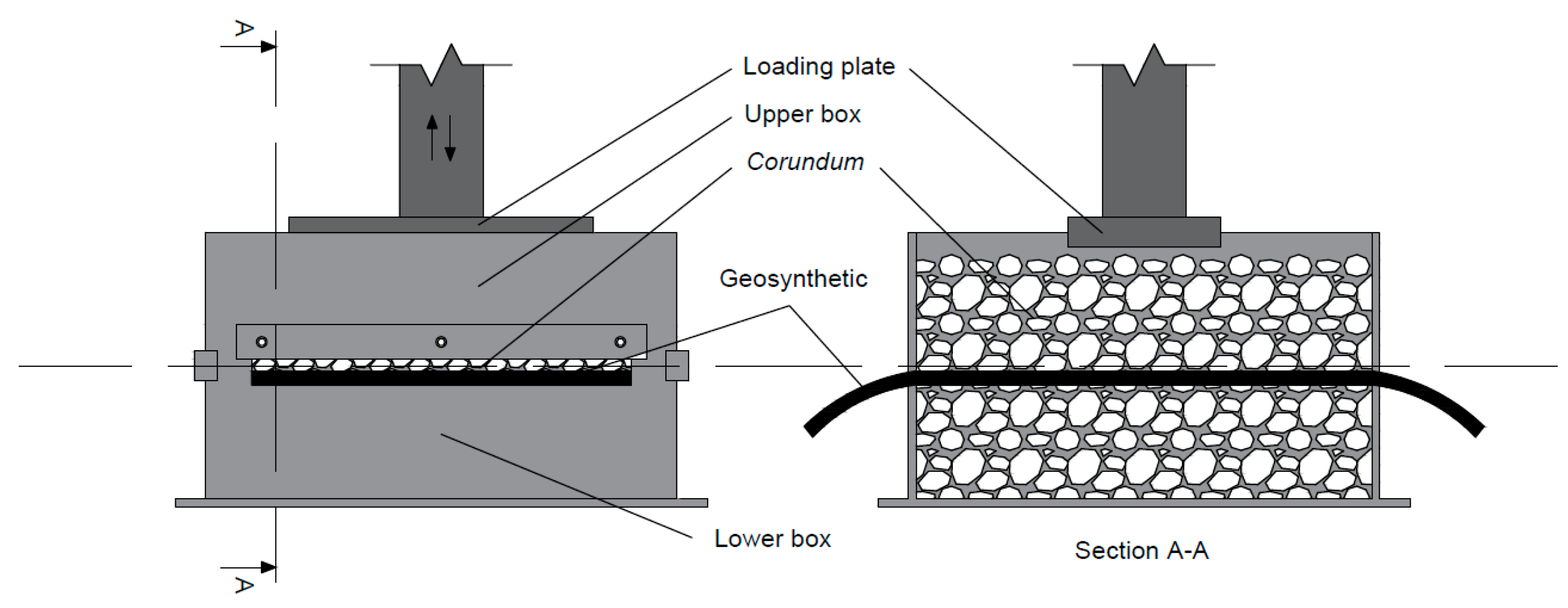
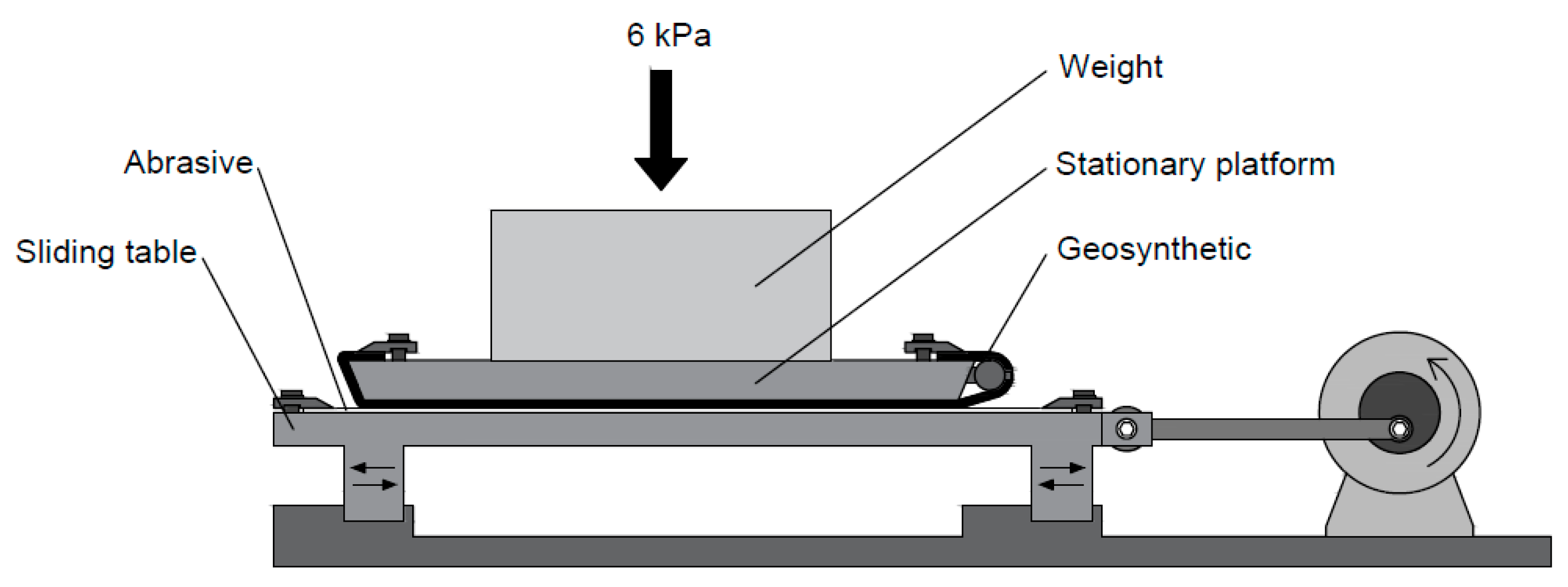
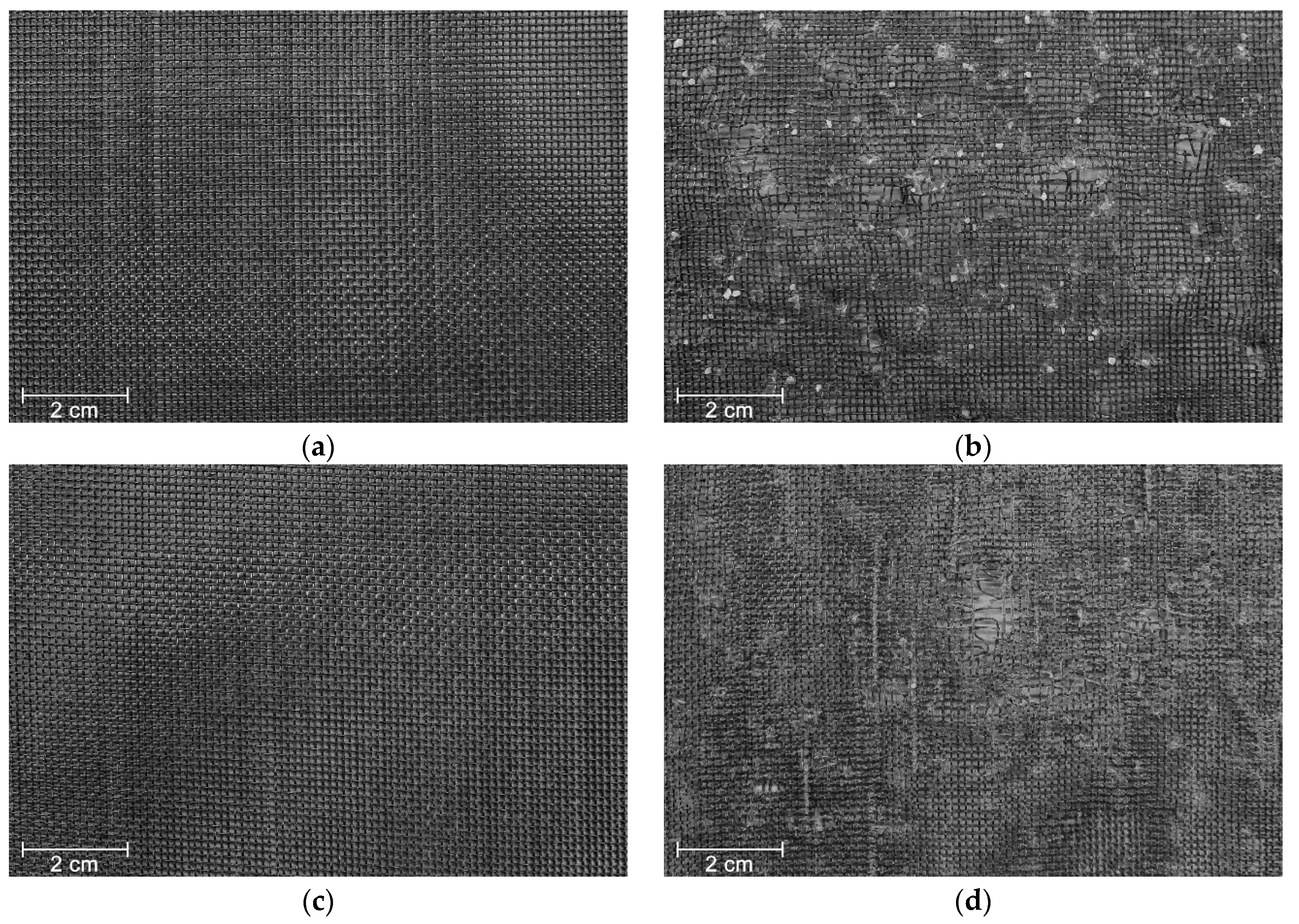
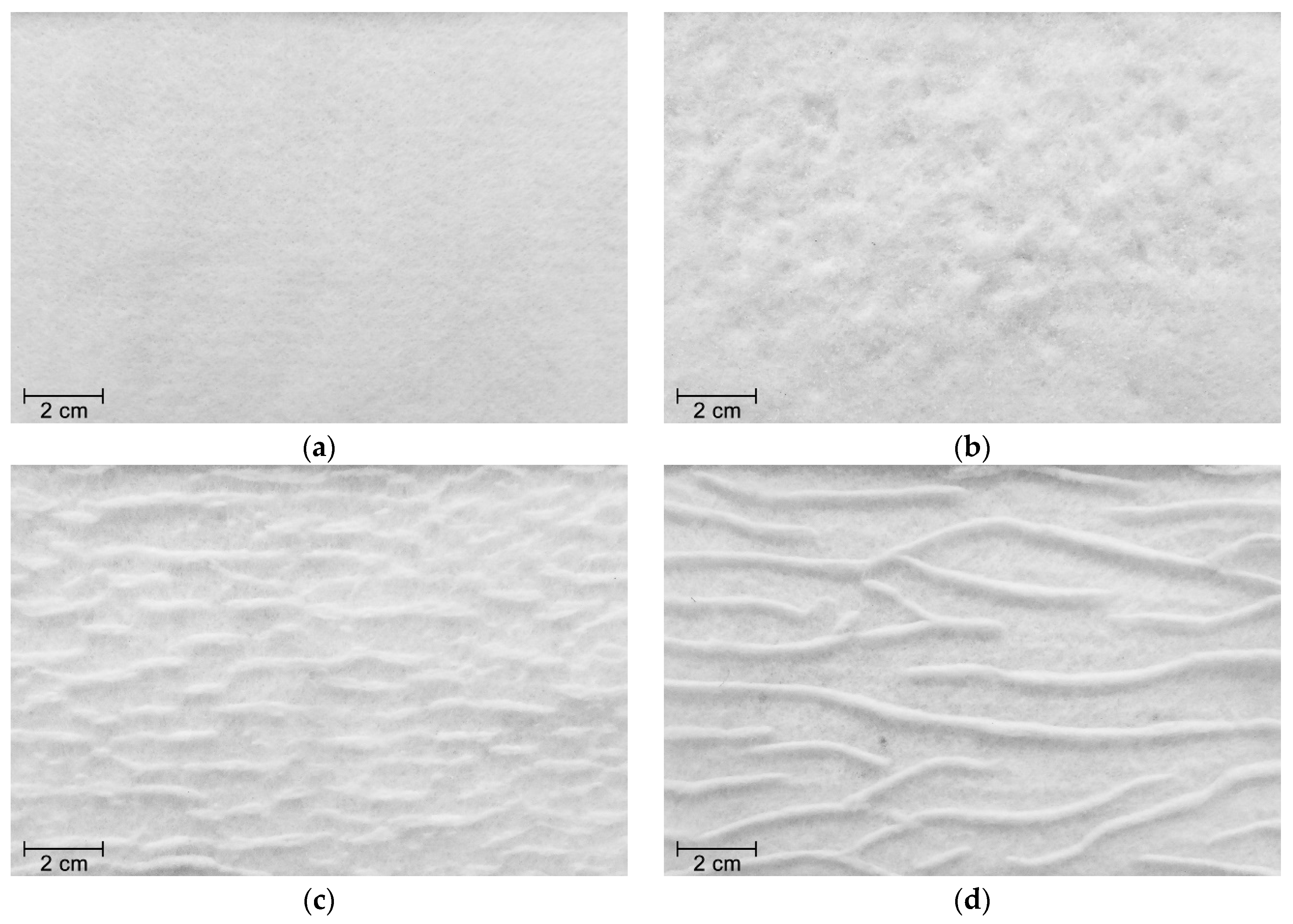
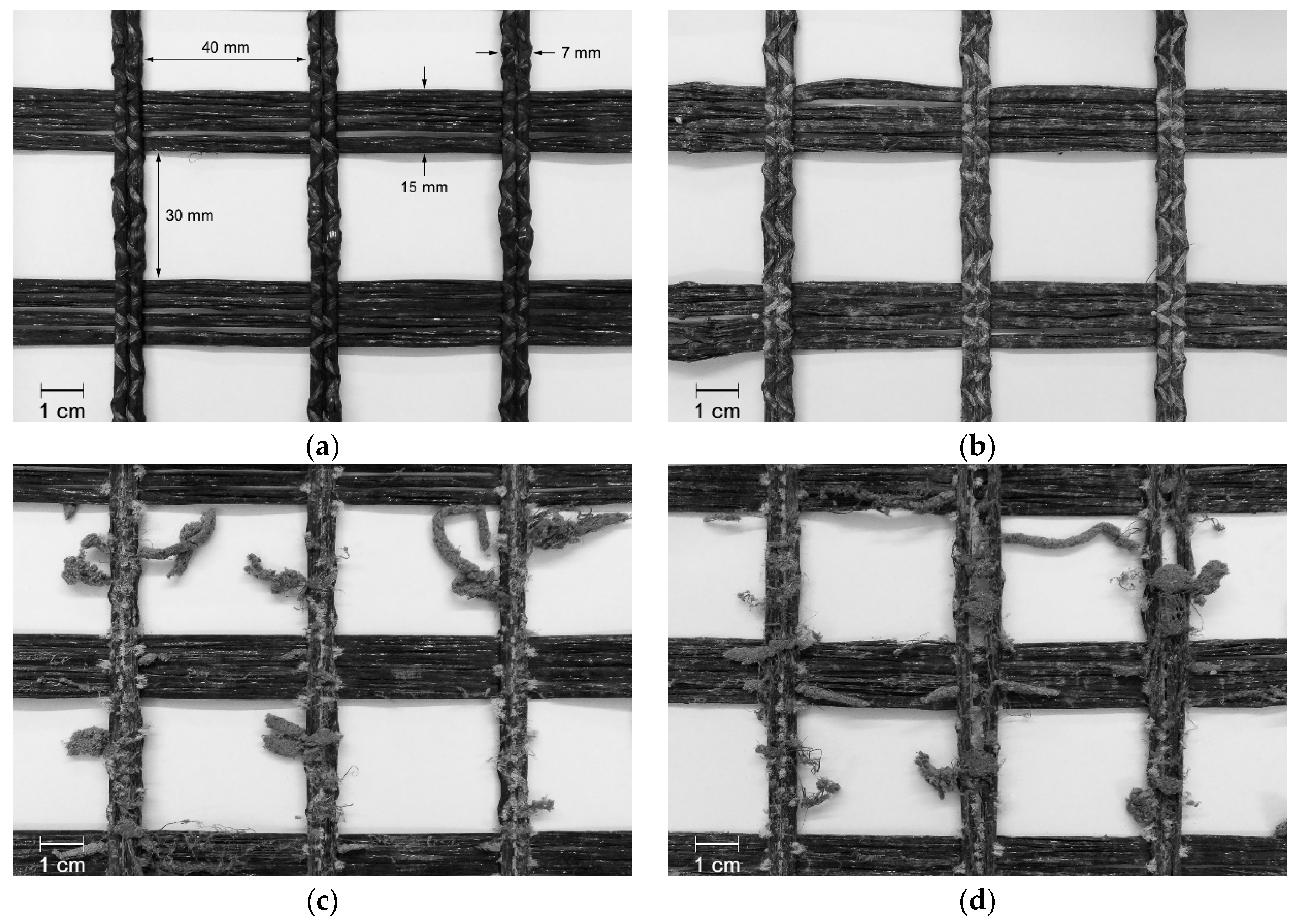
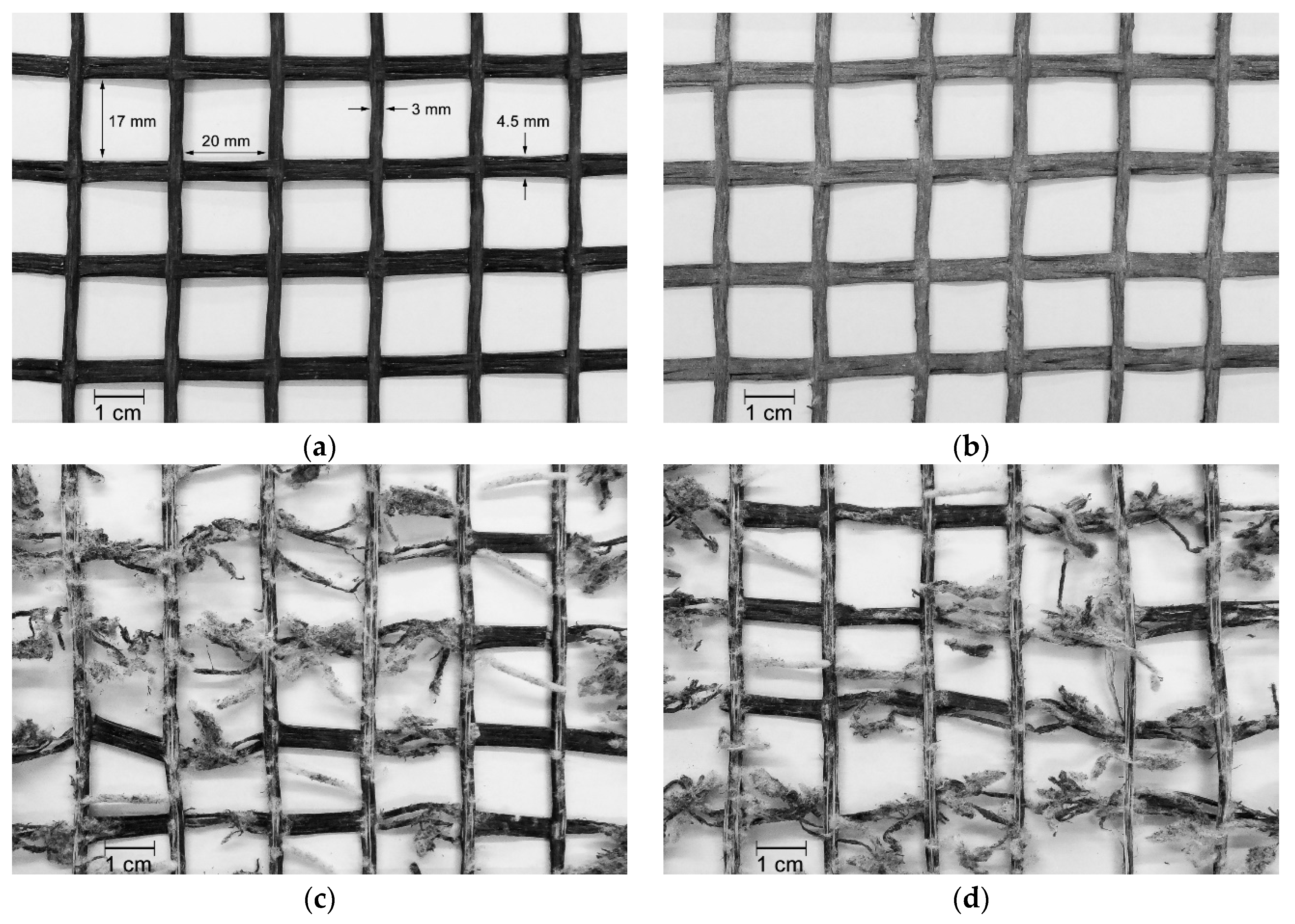
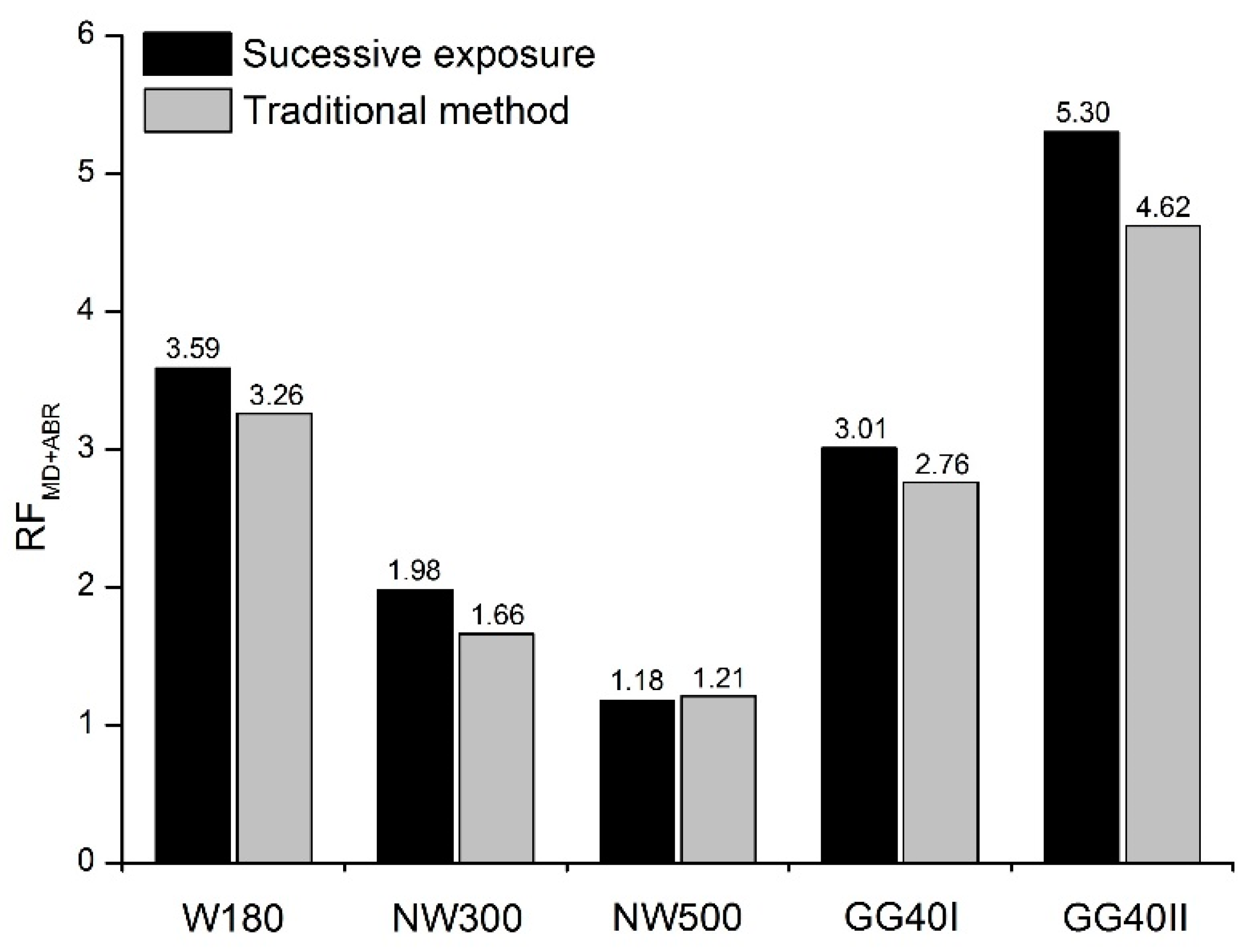
| Geosynthetic | Type | µA (g·m−2) 1 | t (mm) 2 | T (kN.m−1) 3 |
|---|---|---|---|---|
| W180 | Woven geotextile | 193 (± 3) | 0.84 (± 0.01) | 24.80 (± 0.62) |
| NW300 | Nonwoven geotextile | 325 (± 11) | 3.83 (± 0.09) | 23.44 (± 1.33) |
| NW500 | Nonwoven geotextile | 476 (± 12) | 4.68 (± 0.11) | 33.61 (± 2.33) |
| GG40I | Woven geogrid | - | - | 44.36 (± 1.02) |
| GG40II | Woven geogrid | - | - | 39.83 (± 1.74) |
| Degradation Test | T (kN·m−1) | EML (%) |
|---|---|---|
| Undamaged | 24.80 (± 0.62) | 52.7 (± 4.5) |
| MD | 8.84 (± 0.70) | 17.2 (± 1.6) |
| Abrasion | 21.36 (± 0.56) | 34.2 (± 1.6) |
| MD + Abrasion | 6.90 (± 0.61) | 13.2 (± 1.1) |
| Degradation Test | NW300 | NW500 | ||
|---|---|---|---|---|
| T (kN·m−1) | EML (%) | T (kN·m−1) | EML (%) | |
| Undamaged | 23.44 (± 1.33) | 138.4 (± 13.8) | 33.61 (± 2.33) | 135.9 (± 17.6) |
| MD | 16.36 (± 1.79) | 81.0 (± 7.6) | 28.92 (± 2.56) | 104.0 (± 8.3) |
| Abrasion | 20.21 (± 1.33) | 101.7 (± 11.4) | 32.25 (± 2.93) | 104.7 (± 12.8) |
| MD + Abrasion | 11.86 (± 2.28) | 58.9 (± 3.1) | 28.40 (± 1.46) | 95.6 (± 6.7) |
| Degradation Test | GG40I | GG40II | ||
|---|---|---|---|---|
| T (kN·m−1) | EML (%) | T (kN·m−1) | EML (%) | |
| Undamaged | 44.36 (± 1.02) | 12.1 (± 0.2) | 39.83 (± 1.74) | 17.6 (± 0.9) |
| MD | 43.63 (± 3.72) | 10.6 (± 0.5) | 23.76 (± 2.18) | 12.3 (± 1.0) |
| Abrasion | 16.37 (± 1.25) | 6.5 (± 0.5) | 14.50 (± 3.60) | 11.4 (± 1.0) |
| MD + Abrasion | 14.75 (± 1.29) | 6.3 (± 0.7) | 7.52 (± 1.48) | 10.4 (± 2.7) |
| Degradation Test | VH50 (mm·s−1) | |
|---|---|---|
| NW300 | NW500 | |
| Undamaged | 45.2 (± 6.8) | 36.8 (± 3.5) |
| MD | 47.9 (± 3.8) | 36.8 (± 3.2) |
| Abrasion | 57.3 (± 4.2) | 38.6 (± 3.2) |
| MD + Abrasion | 66.5 (± 6.8) | 38.8 (± 2.4) |
| Degradation Test | W180 | NW300 | NW500 | GG40I | GG40II |
|---|---|---|---|---|---|
| MD | 2.81 | 1.43 | 1.16 | 1.02 | 1.68 |
| Abrasion | 1.16 | 1.16 | 1.04 | 2.71 | 2.75 |
© 2019 by the authors. Licensee MDPI, Basel, Switzerland. This article is an open access article distributed under the terms and conditions of the Creative Commons Attribution (CC BY) license (http://creativecommons.org/licenses/by/4.0/).
Share and Cite
Almeida, F.; Carlos, D.M.; Carneiro, J.R.; Lopes, M.d.L. Resistance of Geosynthetics against the Isolated and Combined Effect of Mechanical Damage under Repeated Loading and Abrasion. Materials 2019, 12, 3558. https://doi.org/10.3390/ma12213558
Almeida F, Carlos DM, Carneiro JR, Lopes MdL. Resistance of Geosynthetics against the Isolated and Combined Effect of Mechanical Damage under Repeated Loading and Abrasion. Materials. 2019; 12(21):3558. https://doi.org/10.3390/ma12213558
Chicago/Turabian StyleAlmeida, Filipe, David Miranda Carlos, José Ricardo Carneiro, and Maria de Lurdes Lopes. 2019. "Resistance of Geosynthetics against the Isolated and Combined Effect of Mechanical Damage under Repeated Loading and Abrasion" Materials 12, no. 21: 3558. https://doi.org/10.3390/ma12213558
APA StyleAlmeida, F., Carlos, D. M., Carneiro, J. R., & Lopes, M. d. L. (2019). Resistance of Geosynthetics against the Isolated and Combined Effect of Mechanical Damage under Repeated Loading and Abrasion. Materials, 12(21), 3558. https://doi.org/10.3390/ma12213558





